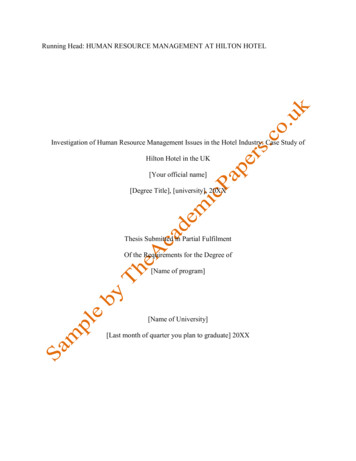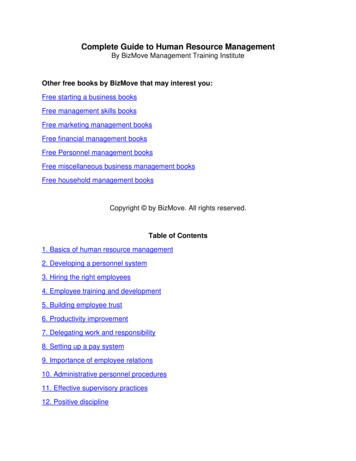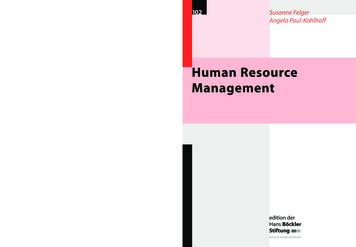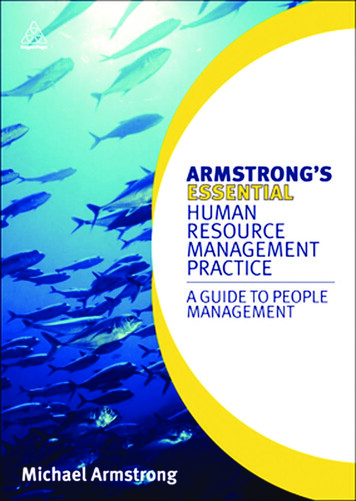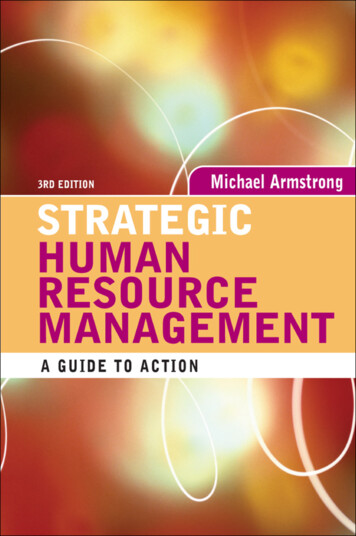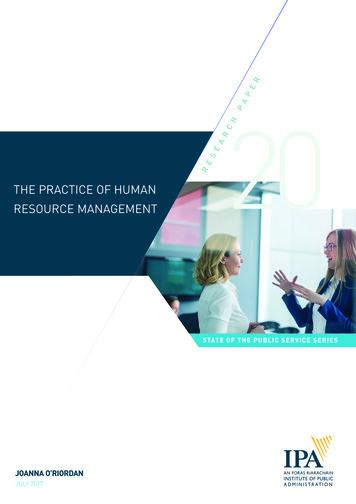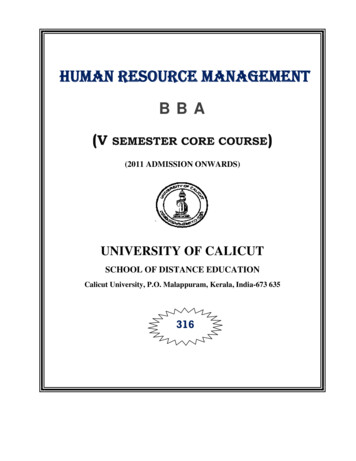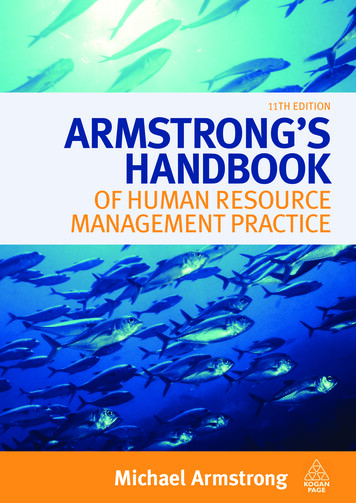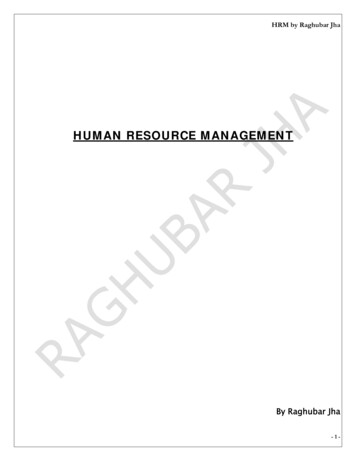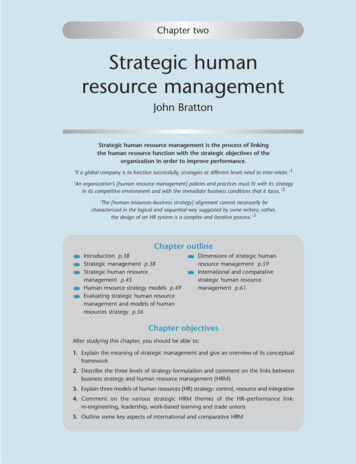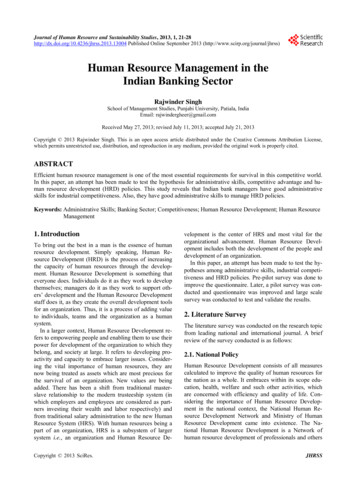
Transcription
Journal of Human Resource and Sustainability Studies, 2013, 1, 21-28http://dx.doi.org/10.4236/jhrss.2013.13004 Published Online September 2013 (http://www.scirp.org/journal/jhrss)Human Resource Management in theIndian Banking SectorRajwinder SinghSchool of Management Studies, Punjabi University, Patiala, IndiaEmail: rajwindergheer@gmail.comReceived May 27, 2013; revised July 11, 2013; accepted July 21, 2013Copyright 2013 Rajwinder Singh. This is an open access article distributed under the Creative Commons Attribution License,which permits unrestricted use, distribution, and reproduction in any medium, provided the original work is properly cited.ABSTRACTEfficient human resource management is one of the most essential requirements for survival in this competitive world.In this paper, an attempt has been made to test the hypothesis for administrative skills, competitive advantage and human resource development (HRD) policies. This study reveals that Indian bank managers have good administrativeskills for industrial competitiveness. Also, they have good administrative skills to manage HRD policies.Keywords: Administrative Skills; Banking Sector; Competitiveness; Human Resource Development; Human ResourceManagement1. IntroductionTo bring out the best in a man is the essence of humanresource development. Simply speaking, Human Resource Development (HRD) is the process of increasingthe capacity of human resources through the development. Human Resource Development is something thateveryone does. Individuals do it as they work to developthemselves; managers do it as they work to support others’ development and the Human Resource Developmentstaff does it, as they create the overall development toolsfor an organization. Thus, it is a process of adding valueto individuals, teams and the organization as a humansystem.In a larger context, Human Resource Development refers to empowering people and enabling them to use theirpower for development of the organization to which theybelong, and society at large. It refers to developing proactivity and capacity to embrace larger issues. Considering the vital importance of human resources, they arenow being treated as assets which are most precious forthe survival of an organization. New values are beingadded. There has been a shift from traditional masterslave relationship to the modern trusteeship system (inwhich employers and employees are considered as partners investing their wealth and labor respectively) andfrom traditional salary administration to the new HumanResource System (HRS). With human resources being apart of an organization, HRS is a subsystem of largersystem i.e., an organization and Human Resource DeCopyright 2013 SciRes.velopment is the center of HRS and most vital for theorganizational advancement. Human Resource Development includes both the development of the people anddevelopment of an organization.In this paper, an attempt has been made to test the hypotheses among administrative skills, industrial competitiveness and HRD policies. Pre-pilot survey was done toimprove the questionnaire. Later, a pilot survey was conducted and questionnaire was improved and large scalesurvey was conducted to test and validate the results.2. Literature SurveyThe literature survey was conducted on the research topicfrom leading national and international journal. A briefreview of the survey conducted is as follows:2.1. National PolicyHuman Resource Development consists of all measurescalculated to improve the quality of human resources forthe nation as a whole. It embraces within its scope education, health, welfare and such other activities, whichare concerned with efficiency and quality of life. Considering the importance of Human Resource Development in the national context, the National Human Resource Development Network and Ministry of HumanResource Development came into existence. The National Human Resource Development is a Network ofhuman resource development of professionals and othersJHRSS
22R. SINGHwho are basically concerned with promotion or expansion of the Human Resource Development movement ina country. It is a non-profit organization and a professional body dedicated to the advancement of knowledge,skills, values and attitudes through education, trainingand experience sharing. The main objectives of nationalHuman Resource Development network include dissemination of knowledge and experience and to facilitatelearning among Human Resource Development people,line managers and all employees that have Human Resource Development role to perform.The efficient HR practices combined with unions shallinfluence organizational efficiency [1]. Firms can generate human capital advantage through recruiting and retaining excellent people [2]. This shall help to developcompetitive advantage. Also, the practices must be linkedto the characteristics of employees, including their expectations and needs [2]. Nelson, [3] suggests that focusing on scarce HR resources, providing insights intohow employees create value and employee contributionfor the success of the organization.2.5. Individual Efficiency2.2. Organizational PolicyOrganizational policy involves the use of processesthrough which the employees of an organization are prepared to give their best for corporate objectives. It involves setting up of a system through which human capabilities and potentials can be tapped resulting in mutualsatisfaction of the individuals and organizations. It is aprocess by which employees of an organization are continuously helped in a planned way to meet the objectivesof an organization. It helps to acquire or sharpen capabilities and improve organizational culture where superior-subordinate relationships, teamwork and collaboration among different subunits are improved for betterorganizational health, dynamism and pride of employees.2.3. Department PolicyDepartment policy involves the processes through whichemployees working within a department are organized todevelop and sharpen skill to meet the organizational objectives. It involves the creation of mutual trust, confidence, transparency and improved process to reduceprocess times in the interest of employees.In the context of an individual: HRD deals with individual values, behavior, action and thoughts. As such itmay be defined as the activities and processes undertakento promote the intellectual, moral, psychological, cultural,social and economic development of an individual so asto achieve his highest human potential as a resource forthe community. In other words, it means an all rounddevelopment of the person so that he can contribute hisbest to the organization, the community and the nation.2.4. Organizational EfficiencyOrganizational efficiency focuses on the use of moneyand other resources. Nonprofit organizations measureefficiency based on the relationship between the effectiveness of services and organizational expenditure. Onthe other-hand business organizations focus on maximization of profits. The organizational performance shall beimproved through several channels, including changes inefficiency, innovation and technological development.Copyright 2013 SciRes.Increasing personal efficiency and productivity can be asatisfying outcome. Increasing efficiency and productivity comes from changing behaviors, not doing morethings. The positive attitude helps in improving personalproductivity more than any of the modern electronicgadgets available today.2.6. Technological DevelopmentTechnology is the practical application of science tocommerce or industry [4]. Human resources tasks cover alarge variety of activities requiring different skills ranging from compensation and benefit administration(highly quantitative) to employee relations (highly qualitative) [5]. Walker [6] suggested that HR technologyshould focus on strategic alignment, business intelligence,efficiency, and effectiveness. It must change the workperformed by HR personnel, by improving service level,allowing more time to work of higher value, and reducing their costs. Lewin [7] found that high involvementpractices had resulted in significant positive improvement on market value, rate of return on capital employed,revenue growth, revenue-per-employee rate, productivity,product/service quality, and even organizational survival.Also, the use of technology by HR has proven to assiston the improvement of business performances. Sartain [8]clarified that, in order for this to happen, HR shouldbring the customer’s voice to inside an organization, andaccomplishing that, upper management will empowerHR to reflect the customer’s value proposition.2.7. Competitive OrganizationJack [9] quoted that in the competitive market today,keeping the business and its people or human resource(HR) competitive is not easy. Competitiveness is one ofthe most important roles of HR professionals to play.Competitiveness focuses on the ability to compete in themarket by learning new ways of doing business. DaveUlrich et al. [10] developed a model for understandingthe synergies of HR professionals for operational andstrategic jobs. The operational aspect focuses on day-today activities on the other-hand strategic aspects haveJHRSS
R. SINGHbecome a part of the management of the organization.Flotter et al. [11] presented a framework and suggestedto focus on: 1) focus on desired strategic outcomes; 2)identification and implementation of essential human resource management actions; and 3) enhancement of competitive advantage. We need to focus on organization’senvironment, mission business strategy, and assessmentof the human resource requirement to attain competitiveadvantage.23ics, and helps to achieve a high performance corporateculture. Human resource management can play a significant role so that corporate social responsibility can become “the way we do things around here” [19]. HR shallbe the key organizational partner to ensure that objectives are achieved through and with people, treating themas stakeholders within the organization. Hence, HRshould be poised for this leadership role as it is adept atworking horizontally and vertically across and within theorganization to compete in this competitive world.2.8. Management CommitmentIt is defined as, “Engaging in and maintaining behaviorthat help others to achieve a goal”. Managers always focus on the best practices for human resource management (HRM). Sometimes this is referred to as “high performance work systems” [12], “high commitment” HRM[13] or “high involvement” HRM [14]. The ultimate objective is to improve the organizational performance bymeasurement of the same. Cooper et al. [15], classifiedmanagement measurement as: directly asking questionsand monitoring. They also reveal that senior managementexperts influence more on the employee motivation.2.9. Degree of FreedomThe labor market force is one of the key factors in determining an organization’s “degrees of freedom” in HRstrategic formation [16]. The demand and availability ofparticular skills, knowledge and expertise, is a key factorto adopt an appropriate HR strategy. The developmentsin the economic, political, technological and socialspheres have significantly changed the labor requirements. Subsequently, an understanding of the labor market context of work organizations is essential to appreciate the challenges faced by HRM in the twenty-first century. Nike INC. [17], suggested that the focus on clarityof position and freedom, freedom of association training,and building trust and association to arrange and managelabor play important role in improving organizationalperformance.2.10. Efficient Organizational DevelopmentBolton and Abdy, [18] quoted that organizational development is about “strengthening organizations so that theycan better achieve their mission.” Also, it is about beingboth effective achievement of objectives and efficient useof resources. Hence, it’s about doing the right thing; butit’s also about doing things right.2.11. Objective AchievementHuman resource management influences many of the keysystems; business processes underpinning effective delivery as well as fosters corporate social responsibility ethCopyright 2013 SciRes.2.12. Cultural SupportIt is a set of common understandings around which action is organized, finding expression in a language whosenuances are peculiar to the group [20]. Becker [20] classified the culture as; weak or strong, inhibitive or facilitative, and consistent or inconsistent. The cultural influences show how members of an organization behave aswell perceive to a situation. Heathfield [21] quoted that itis more difficult to change the existing organizationalculture than to create a culture in a new organization.When an organizational culture is already established,people must unlearn the old values, assumptions, andbehaviors before they can learn the new ones. The mostimportant elements for creating organizational culturalchange are executive support and training. Executives inthe organization should not only support the culturalchanges in ways beyond verbal support but also providethe behavioral support to change the culture. Hence, developing a culture where all the employees work togetheras team plays an important role to survive in this competitive world.2.13. Conflict ManagementIn most conflicts the different perceptions collide to create disagreement. Conflict is natural and needs to respond quickly and professionally. It can be resolved formally or informally. Successful conflict resolution occursby listening to the problems of all the parties and providing the most viable solution. The differences shall bemitigated by stimulating creativity, promoting innovation,and change management. Mismanaged conflicts and disagreements harm important work and workplace relationships. Hence, effectively managed conflict promotescooperation and builds stronger relationships.2.14. Management AttitudeLise et al. [22] quoted that the industrial psycho
Nike INC. [17], suggested that the focus on clarity of position and freedom, freedom of association training, . Human resource management can play a signifi- cant role so that corporate social responsibility can be- come “the way we do things around here” [19]. HR shall be the key organizational partner to ensure that objec- tives are achieved through and with people, treating them as .File Size: 592KBPage Count: 8

